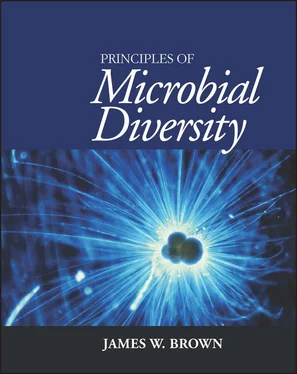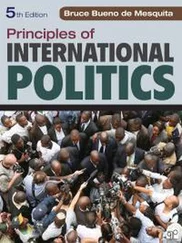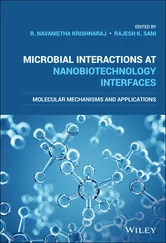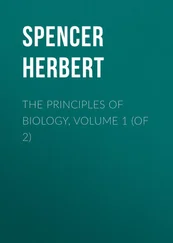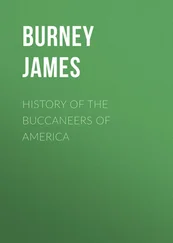
Figure 4.6Measuring phylogenetic distances in phenograms. doi:10.1128/9781555818517.ch4.f4.6
PROBLEMS
1 1. Answer the following questions on this tree:a. Which are the two most closely related species?b. Which is the most primitive of these species?c. Which of these is probably the outgroup?d. Which is most distantly related to the Gremlin other than the outgroup species?e. Circle the last common ancestor of the Hippogriff and the Gremlin.f. Redraw this tree to scale as a phenogram.
2 2. Answer the following questions about this tree:

1 a. Which are the two most closely related species?
2 b. Which of these is probably the outgroup?
3 c. Based on the outgroup from question b, circle the last common ancestor of the remaining creatures.
4 d. Now circle the root of the tree (again, assuming the same outgroup).
5 e. Circle the two main groups in this tree (other than the outgroup).
6 f. Which is most distantly related to the Drosophila other than the outgroup species?
7 g. Which species in this tree is most closely related to Homo?
8 h. Redraw this tree as a phenogram.
3.Answer the following questions about this tree:

1 a. Which organism is the closest relative of Chromatium vinosum?
2 b. Which organism(s) is the outgroup?
3 c. Circle the root of the tree based on this outgroup?
4 d. What is the evolutionary distance between Thermus thermophilus and Thermomicrobium roseum?
5 e. What is the evolutionary distance between Chloroflexus aurantiacus and Methanococcus vannielii?
6 f. Which organism(s) is/are most closely related to Chloroflexus aurantiacus and Thermomicrobium roseum?
7 g. EM3 is an unknown organism. What is its closest relative on this tree?
8 h. Excluding the outgroup, which is the most primitive organism (or at least sequence) in this tree?
9 i. Excluding the outgroup, which is the most highly evolved organism (or sequence) in this tree?
10 j. Circle the last common ancestor of Chromatium vinosum and Deinococcus radiodurans.
11 k. Redraw this tree as a dendrogram.
In about 1990, an organism designated ES-2 was isolated from a deep-sea hydrothermal vent sample. ES-2 grows heterotrophically at 65°C. A lipid analysis of the isolate was unusual, showing that it contained a number of apparently branched lipids as well as fatty acids. Electron microscopy and standard microbiological tests were not helpful in identifying the organism.
Phylogenetic analysis of the organism was performed essentially as above. DNA was isolated from cells, and the SSU rRNA was amplified by PCR using primers near both the 5′ and 3′ ends of the gene. The amplified DNA was cloned and sequenced (Fig. 4.7), and the secondary structure of the encoded RNA was determined for use in the alignment process (Fig. 4.8).

Figure 4.7Sequence of the ES-2 SSU rRNA, in GenBank format. doi:10.1128/9781555818517.ch4.f4.7
With the sequence in hand, the next step in the process was to align the sequence with the SSU rRNA database. This was originally done by hand in a local database, but these days it can be done automatically at the Ribosomal Database Project (RDP), using an algorithm called “infeRNAl” (from INFER RNA ALignment). After this, the next step was to calculate phylogenetic trees; the RDP uses a weighted neighbor-joining method. First, a “representative” tree was generated using representative sequences from each major phylogenetic group of bacteria to see which group ES-2 seems to belong to (Fig. 4.9).

Figure 4.8Secondary structure of the ES-2 SSU rRNA sequence. This is a hand-drawn image, because that is the way these structures are usually sorted out. doi:10.1128/9781555818517.ch4.f4.8

Figure 4.9Phylum-scale tree including ES-2, generated using the RDP II website. doi:10.1128/9781555818517.ch4.f4.9
ES-2 is clearly most closely related to the representative of the phylum Firmicutes (represented by Bacillus mycoides ). So, the next step was to generate another tree by using representative sequences from the Firmicutes (Fig. 4.10). At the time this analysis was performed, only a few such sequences were available. Now there are thousands of Firmicute sequences in the database.
This tree shows that ES-2 is a member of the Clostridium/Eubacterium group of the Firmicutes. So a final tree with representatives of this group, and some especially close relatives identified using BLAST was generated (Fig. 4.11).

Figure 4.10Tree of representative Firmicutes, including ES-2, generated using the RDP II website. doi:10.1128/9781555818517.ch4.f4.10

Figure 4.11Fine-scale phylogenetic tree of ES-2, generated using the RDP II website. doi:10.1128/9781555818517.ch4.f4.11
ES-2 is a member of the Clostridium/Eubacterium group of the Firmicutes, and is particularly close (probably deserves to be in the same genus or even species) to Caloranaerobacter azorensis , a more recent deep-sea vent isolate. At the time of this analysis (but no longer), organisms from this group that produce spores were considered to be in the genus Clostridium , while those that did not produce spores were classified as Eubacterium . Because of the environment from which it was isolated, the new species was named Eubacterium thermomarinus .
What good was this information?
This information was very useful; we were interested in identifying organisms that were very distinct from those already in hand for analysis of RNase P RNA structure. Given that this was basically a member of the genus Clostridium , from which we already had several sequences, this organism became a low priority and was not pursued further. Knowing the phylotype of ES-2 prevented us from spending a fair amount of effort for what would have been trivial gain.
1 1. Which organism would you choose for an outgroup for an rRNA tree of mammals? Does it matter which nonmammal you choose? Why? What might you choose as an outgroup for an rRNA tree of Bacteria? What about for a “universal tree” containing sequences of all kinds of organisms?
Читать дальше
